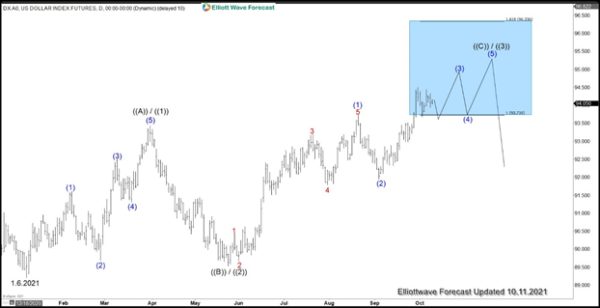Since bottoming earlier this year, US Dollar has steadily caught a bid. One of the primary reasons for the USD strength is because of the expectation that the Fed will start tapering later this year. The Fed has communicated their intent to reduce the emergency measures as the economy starts to recover from global pandemic. The market has more or less priced in this tapering. In the last Fed’s meeting, Chairman Powell indicated a taper ending around mid-2022 may be appropriate.
What is less clear however is how fast the Fed would raise interest rate and returns to a normal monetary policy. Inflation has been well above the the Fed’s 2% target. Even using the Fed’s preferred gauge for inflation, prices were up 3.6% in July year-over-year. The “dot-plot” of interest rate projection shows an even split between Fed officials who see interest liftoff in 2022 and those who see it later than that. Eight of the Fed members saw first interest rate hike in 2023.
We will look at the weekly Elliott Wave chart for Dollar Index (DXY) below to see the expected move.
The Dollar Index (DXY) has reached inflection area from January 6, 2021 low at the blue box area of 93.7 – 96.3. The current rally from January 6, 2021 low is in 3 swing so far. It could be either an ((A))-((B))-((C)) in a bearish scenario, or ((1))-((2))-((3)) in a bullish scenario. If the move higher extends to 161.8% Fibonacci extension at 96.3, then the odd that it becomes a wave ((3)) of an impulse will increase. As far as it stays within the box, then the move up can be a zigzag ((A))-((B))-((C)).
As the Index has reached blue box, it can soon turn lower in 3 waves at least. Shorter cycle, further upside extension can’t be ruled out. However, a 3 waves pullback can soon happen assuming an ((A))-((B))-((C)) rally from January 6, 2021 low. This view will become less likely if the Dollar Index is able to rally to 161.8% extension at 96.3. If this happens, we may become more bullish in the index.














